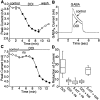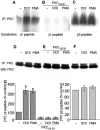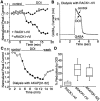Serotonin receptors modulate GABA(A) receptor channels through activation of anchored protein kinase C in prefrontal cortical neurons
- PMID: 11517239
- PMCID: PMC6763081
- DOI: 10.1523/JNEUROSCI.21-17-06502.2001
Serotonin receptors modulate GABA(A) receptor channels through activation of anchored protein kinase C in prefrontal cortical neurons
Abstract
Serotonergic neurotransmission in prefrontal cortex (PFC) has long been known to play a key role in regulating emotion and cognition under normal and pathological conditions. However, the cellular mechanisms by which this regulation occurs are unclear. In this study, we examined the impact of serotonin on GABA(A) receptor channels in PFC pyramidal neurons using combined patch-clamp recording, biochemical, and molecular approaches. Application of serotonin produced a reduction of postsynaptic GABA(A) receptor currents. Although multiple 5-HT receptors were coexpressed in PFC pyramidal neurons, the serotonergic modulation of GABA-evoked currents was mimicked by the 5-HT(2)-class agonist (-)-2,5-dimethoxy-4-iodoamphetamine and blocked by 5-HT(2) antagonists risperidone and ketanserin, indicating the mediation by 5-HT(2) receptors. Inhibiting phospholipase C blocked the 5-HT(2) inhibition of GABA(A) currents, as did dialysis with protein kinase C (PKC) inhibitory peptide. Moreover, activation of 5-HT(2) receptors in PFC slices increased the in vitro kinase activity of PKC toward GABA(A) receptor gamma2 subunits. Disrupting the interaction of PKC with its anchoring protein RACK1 (receptor for activated C kinase) eliminated the 5-HT(2) modulation of GABA(A) currents, suggesting that RACK1-mediated targeting of PKC to the vicinity of GABA(A) receptors is required for the serotonergic signaling. Together, our results show that activation of 5-HT(2) receptors in PFC pyramidal neurons inhibits GABA(A) currents through phosphorylation of GABA(A) receptors by the activation of anchored PKC. The suppression of GABAergic signaling provides a novel mechanism for serotonergic modulation of PFC neuronal activity, which may underlie the actions of many antidepressant drugs.
Figures







Similar articles
-
Activity-dependent bidirectional regulation of GABA(A) receptor channels by the 5-HT(4) receptor-mediated signalling in rat prefrontal cortical pyramidal neurons.J Physiol. 2002 May 1;540(Pt 3):743-59. doi: 10.1113/jphysiol.2001.013391. J Physiol. 2002. PMID: 11986365 Free PMC article.
-
Serotonin receptor activation inhibits sodium current and dendritic excitability in prefrontal cortex via a protein kinase C-dependent mechanism.J Neurosci. 2002 Aug 15;22(16):6846-55. doi: 10.1523/JNEUROSCI.22-16-06846.2002. J Neurosci. 2002. PMID: 12177182 Free PMC article.
-
Dopamine D4 receptors modulate GABAergic signaling in pyramidal neurons of prefrontal cortex.J Neurosci. 2002 Nov 1;22(21):9185-93. doi: 10.1523/JNEUROSCI.22-21-09185.2002. J Neurosci. 2002. PMID: 12417643 Free PMC article.
-
Regulation of GABAergic inhibition by serotonin signaling in prefrontal cortex: molecular mechanisms and functional implications.Mol Neurobiol. 2002 Oct-Dec;26(2-3):203-16. doi: 10.1385/MN:26:2-3:203. Mol Neurobiol. 2002. PMID: 12428756 Review.
-
[Serotonergic control of prefrontal cortex].Rev Neurol. 2004 Sep 16-30;39(6):539-47. Rev Neurol. 2004. PMID: 15467993 Review. Spanish.
Cited by
-
mGluR-LTD at Excitatory and Inhibitory Synapses in the Lateral Habenula Tunes Neuronal Output.Cell Rep. 2016 Aug 30;16(9):2298-307. doi: 10.1016/j.celrep.2016.07.064. Epub 2016 Aug 18. Cell Rep. 2016. PMID: 27545888 Free PMC article.
-
Serotonin facilitates long-term depression induction in prefrontal cortex via p38 MAPK/Rab5-mediated enhancement of AMPA receptor internalization.J Physiol. 2008 Sep 15;586(18):4465-79. doi: 10.1113/jphysiol.2008.155143. Epub 2008 Jul 24. J Physiol. 2008. PMID: 18653660 Free PMC article.
-
Domestication of the dog from the wolf was promoted by enhanced excitatory synaptic plasticity: a hypothesis.Genome Biol Evol. 2014 Nov 5;6(11):3115-21. doi: 10.1093/gbe/evu245. Genome Biol Evol. 2014. PMID: 25377939 Free PMC article.
-
Associations between prefrontal γ-aminobutyric acid concentration and the tryptophan hydroxylase isoform 2 gene, a panic disorder risk allele in women.Int J Neuropsychopharmacol. 2013 Sep;16(8):1707-17. doi: 10.1017/S1461145713000254. Epub 2013 Apr 3. Int J Neuropsychopharmacol. 2013. PMID: 23552096 Free PMC article.
-
Subanaesthetic ketamine treatment alters prefrontal cortex connectivity with thalamus and ascending subcortical systems.Schizophr Bull. 2013 Mar;39(2):366-77. doi: 10.1093/schbul/sbr144. Epub 2011 Nov 22. Schizophr Bull. 2013. PMID: 22114100 Free PMC article.
References
-
- Abi-Dargham A, Laruelle M, Aghajanian GK, Charney D, Krystal J. The role of serotonin in the pathophysiology and treatment of schizophrenia. J Neuropsychiatry Clin Neurosci. 1997;9:1–17. - PubMed
-
- Andrade R. Regulation of membrane excitability in the central nervous system by serotonin receptor subtypes. Ann NY Acad Sci. 1998;861:190–203. - PubMed
-
- Araneda R, Andrade RA. 5-HT2 and 5-HT1A receptors mediate opposing responses on membrane excitability in rat association cortex. Neuroscience. 1991;40:399–412. - PubMed
-
- Battaini F, Pascale A, Paoletti R, Govoni S. The role of anchoring protein RACK1 in PKC activation in the aging rat brain. Trends Neurosci. 1997;20:410–415. - PubMed
-
- Baxter G, Kennett G, Blaney F, Blackburn T. 5-HT2 receptor subtypes: a family re-united? Trends Pharmacol Sci. 1995;16:105–110. - PubMed
Publication types
MeSH terms
Substances
Grants and funding
LinkOut - more resources
Full Text Sources
Other Literature Sources
Miscellaneous
